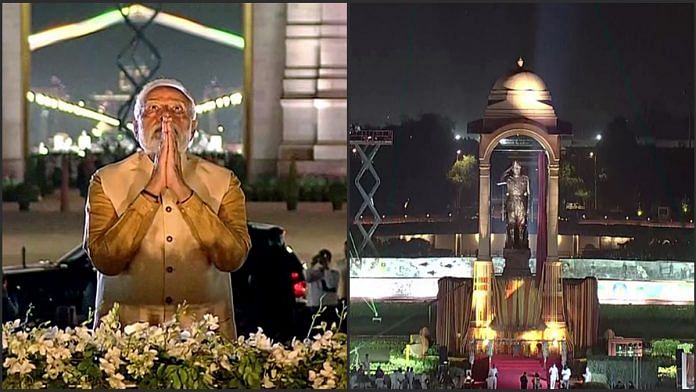New Delhi: Prime Minister Narendra Modi Thursday inaugurated the new-look Central Vista Avenue in the heart of Delhi, which covers the 3-kilometre-long Rajpath or Kartavya Path and its surrounding lawns.
Modi also unveiled a 28-foot statue of Netaji Subhash Chandra Bose near India Gate, the war memorial astride the Kartavya Path.
The overhaul of the Avenue, which stretches from Vijay Chowk to India Gate, is the first chapter in the Central Vista Redevelopment Project, aimed at giving Delhi’s colonial-era power corridor a complete makeover.
The need to revamp the Avenue rose as the existing structure had undergone significant wear and tear due to heavy use.
The path sports a 1.5-km granite pavement on both sides, 99 acres of expansive lawns, 16 food stalls, an amphitheatre for open-air performances, low-level bridges over refurbished canals, and improved public amenities.
The Rs 477-crore Avenue was initially supposed to be completed by December 2021 but the project missed two more deadlines in May and July 2022.
The arterial road Rajpath has been freshly renamed Kartavya Path which, according to Narendra Modi’s personal website, “symbolises a shift from erstwhile Rajpath being an icon of power to Kartavya Path being an example of public ownership and empowerment”.
On Thursday evening, the Prime Minister first unveiled the Netaji statue beneath the canopy near India Gate. He then interacted with the “shramjeevis” or workers who worked on the Central Vista project. He assured all of them an invitation to the next 26 January Republic Day Parade.
Modi then viewed an exhibition on Central Vista Avenue.
At the inauguration of Kartavya Path, the Prime Minister said: “Today, we are eyewitnesses to a historic event. We have left behind the old times, and have injected new colour into our future. The glow that we see is that of India’s self-confidence.”
Modi said “another symbol of servitude”, the Kingsway or Rajpath, had been wiped out forever. “A new era has begun in the form of Kartavya Path. I congratulate the people of the country as we come out from another symbol of colonialism,” he added.
Modi said by installing Netaji’s statue on Kartavya Path, new life had been infused into the Indian ethos. “He will now inspire and guide us,” the PM said.
Praising Netaji as a visionary, Modi said the freedom fighter was “forgotten” after Independence. “If India had walked Bose’s path, it would have attained greater heights,” he said.
On the renaming of Rajpath, Modi said: “Rajpath was for the British… for whom the people of India were slaves. It was a symbol of colonialism. Now, its architecture has changed, and so has its spirit.”
He also said changes brought about were not limited to symbols but also reflected in policies, like in the repeal of outdated laws.
Subhas Chandra Bose’s daughter Anita Bose Pfaff told a television channel that the statue was a “befitting memorial” to the freedom fighter. “I feel very proud that Netaji has such a place,” she said.
The overall Central Vista Revamp Project – estimated at Rs 20,000 crore — is being implemented in a phased manner by the Central Public Works Department (CPWD). Gujarat-based architect Bimal Patel’s firm HCP Designs had won the bid in October 2019 to design the project.
Other structures coming in the redevelopment project are a new triangle-shaped Parliament, a new residence for the Prime Minister, and 10 new building blocks to accommodate government offices, including Shastri Bhawan, Nirman Bhawan, Udyog Bhawan, Krishi Bhawan and Vayu Bhawan. Some of the older structures will be converted into museums.
These buildings currently house the offices of different central ministries such as education, health, housing, agriculture, commerce, as well as of the Indian Air Force.
A walkway and a cycling path linking India Gate to the Yamuna River is also on the cards.
The whole project, which began with the laying of the foundation stone of the new Parliament on 10 December 2020, has a final deadline of 2026.
The Central Vista was first designed by English architects Edwin Lutyens and Herbert Baker when the Capital of the Raj was moved from Calcutta to Delhi. The Parliament took six years to build and was inaugurated by Viceroy Lord Irwin in January 1927. After Independence, the Central Vista became the seat of India’s government.
The Parliament campus was declared a heritage precinct in the 1962 Master Plan of Delhi.
Also read: Netaji statue: Sourced from T’gana quarry; makeshift road was built to transport the giant stone






